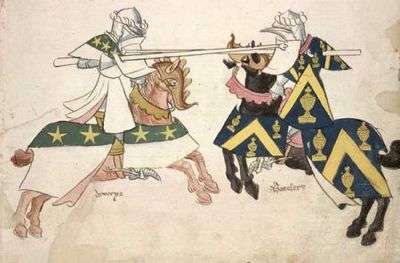Agnes Hotot
Agnes Hotot was a 14th-century English noblewoman known for besting a man in a lance fight. She took her father's place in a duel after he fell ill, disguising herself as a man, and only revealed her true identity after knocking her opponent off his horse. After Hotot married, her husband's family in Clapton, Northhamptonshire (now Clopton) commemorated her exploits with a new crest depicting a woman wearing a war helmet. Her story was recorded by a monk in Clapton.

Biography
Agnes Hotot was a young heiress of the family of Hotot.[1][2] Her father was Sir John Hotot.[3]
Hotot's father was involved in a dispute with a man named Ringsley, and in order to settle it they arranged to have a lance fight. Shortly before the duel, however, Hotot's father fell ill with gout, so "rather than he should lose the land, or suffer in his honor", Hotot disguised herself in her father's armour and fought in his place at the tourney. She knocked Ringsley off his horse.[4][1] As her opponent lay in the dirt, Hotot took off her helmet and let down her hair to reveal her true identity.[5][6] Some accounts state that she also removed her breastplate to expose herself as a woman.[7][6]
In 1395, Hotot married into the Northamptonshire Dudleys of Clapton[8] (now Clopton[3][1]). The Dudley family created a new crest in commemoration of Hotot's lance victory, which included "a woman's bust, her hair disheveled, bosom bare, a helmet on her head, with the stay or throat-latch down", and the Dudley family displayed this crest for many years afterwards.[2][1][6][9] Hotot's story was recorded by a monk in the village of Clapton.[9][4]
More modern accounts of Hotot have combined her story with the legend of "Skulking Dudley": a man from the Dudley family who, after supposedly committing murder in the 1300s, returned to haunt Clopton villagers in the early 20th century. In this modern version, Agnes was the daughter of Skulking Dudley; her father offends a nearby landowner, then cowardly feigns illness to escape the duel, and Agnes takes his place to save the family honour. Although she loses the fight, her opponent discovers her identity, spares her life, and marries her.[3]
References
- 1 2 3 4 Grazebrook, Henry Sydney (1873). The heraldry of Worcestershire. John Russell Smith. pp. 176–177.
- 1 2 Millington, Ellen J. (1858). Heraldry in History, Poetry, and Romance. Chapman and Hall. p. 296.
- 1 2 3 Westwood, Jennifer (2013-10-31). Haunted England: The Penguin Book of Ghosts. Penguin UK. ISBN 9780141959535.
- 1 2 Dobson, Susanna Dawson (1795). Historical anecdotes of heraldry and chivalry: tending to shew the origin of many English and foreign coats of arms, circumstances and customs. Printed by Hall and Brandish. p. 229.
- ↑ Kasparek, Rick (2014-12-05). Knight of the Grail Code. WestBow Press. p. 122. ISBN 9781490862002.
- 1 2 3 Salmonson, Jessica Amanda (2015-04-07). The Encyclopedia of Amazons: Women Warriors from Antiquity to the Modern Era. Open Road Media. ISBN 9781453293645.
- ↑ Frankel, Valerie Estelle (2014-04-11). Women in Game of Thrones: Power, Conformity and Resistance. McFarland. pp. 44–45. ISBN 9781476615547.
- ↑ Dudley, Dean (1848). The Dudley Genealogies and Family Records. The author. p. 15.
- 1 2 Burke, J. Bernard. The Heraldic Register. Lulu.com. p. 17. ISBN 9780995724655.